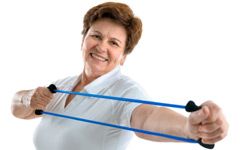Resistance training, also known as strength training, is a form of slow, controlled exercise that forces your muscles to perform against tension, such as against an elastic band, free weights or cable machine. Making resistance training part of your exercise routine can help to improve your muscle strength, balance, coordination, flexibility and range of motion while fighting bone loss and easing the symptoms of arthritis pain.
It may surprise you, then, that many adults over the age of 70 aren't reaping these benefits -- about 40 percent of women and 30 percent of men in that age group report that they don't exercise at all [source: Kotz]. And even if you do work out regularly, chances are you skip strength training and go straight for endurance exercises such as walking or swimming. The best workouts are those that include both aerobic activities as well as strength, balance and flexibility exercises. The American College of Sports Medicine and the American Heart Association recommend that older adults (ages 65 and older) aim for a minimum of 2 1/2 hours (150 minutes) of physical activity every week, including resistance exercises at least two days every week.
Advertisement
You'll really begin to notice the changes in your body as you go about your daily life. With regular resistance training, you'll notice that doing the things we usually take for granted in our younger years, such as carrying groceries into the house or climbing the stairs, becomes easier.
Let's look at five resistance exercises you can do safely with a resistance band in your own home that will improve both your strength and mobility.
